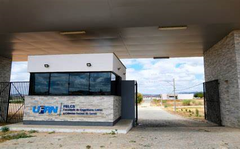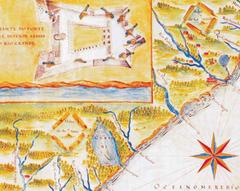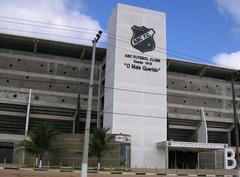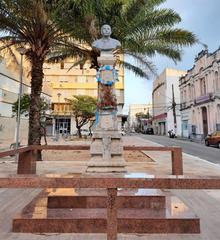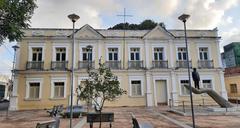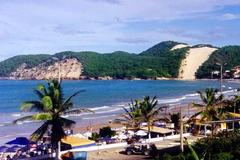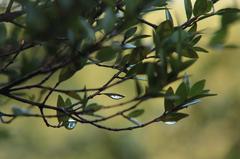
Museu de Cultura Popular Djalma Maranhão: Visiting Hours, Tickets, and Travel Guide in Natal, Brazil
Date: 04/07/2025
Introduction
Located in the historic Ribeira district of Natal, Brazil, the Museu de Cultura Popular Djalma Maranhão is a cornerstone for those seeking to experience the vibrant traditions and folk heritage of Rio Grande do Norte and the broader Northeast region. Established in honor of Djalma Maranhão, a former mayor known for his commitment to education and cultural enrichment, the museum has, since its 2008 inauguration, played a crucial role in preserving and showcasing the artistry, everyday life, and regional identity of the Potiguar people.
Housed in a repurposed colonial-era bus terminal, the museum’s architecture weaves seamlessly into Natal’s historical urban fabric, offering a unique setting for its extensive collection. With over 1,000 artifacts—including musical instruments, costumes, handicrafts, and the celebrated Literatura de Cordel—the museum presents a comprehensive narrative of local culture, from religious expressions to contemporary artistic innovations.
As a living institution, the Museu de Cultura Popular Djalma Maranhão goes beyond static displays, engaging the community through interactive exhibits, multimedia features, educational programs, and collaborations with artists and schools. It stands as an essential stop for visitors interested in understanding the roots, evolution, and ongoing vibrancy of Natal’s cultural life.
Note: As of mid-2025, the museum is temporarily closed for renovations. Prospective visitors should consult official sources for reopening details and any changes in operating hours.
For further information, please refer to the Cadastro Nacional de Museus, the official museum website, and the Natal tourism portal.
Table of Contents
- Historical Background and Building
- Permanent and Temporary Collections
- Visiting Information: Hours, Tickets, Accessibility
- Exhibition Layout and Thematic Organization
- Interactive and Educational Resources
- Nearby Attractions and Travel Tips
- Cultural and Community Significance
- FAQs
- Plan Your Visit
- References
Historical Background and Building
The Museu de Cultura Popular Djalma Maranhão was established as a municipal initiative to safeguard and promote the everyday culture of Rio Grande do Norte. Officially created by Law No. 5.786 in 2007 and opened in 2008, the museum commemorates Djalma Maranhão’s legacy as a champion of cultural democratization. Its mission is rooted in sociomuseology, emphasizing the museum’s social function and engagement with the community (Cadastro Nacional de Museus).
Situated at Praça Augusto Severo, s/n, Largo Dom Bosco, in the Ribeira district, the museum occupies the former Natal bus terminal—a space that has been thoughtfully adapted to serve as a vibrant center for cultural preservation and education. The building’s architecture, marked by colorful ribbons and signage, sets an inviting tone for visitors and reflects the museum’s commitment to inclusivity (visit.natal.br).
Permanent and Temporary Collections
Permanent Collections
The museum’s permanent collection features approximately 1,500 pieces from around 400 artists, encompassing:
- Traditional musical instruments central to regional festivities
- Costumes and textiles from festivals like Festa de São João and Carnival
- Handicrafts and utilitarian objects reflecting local craftsmanship
- Religious artifacts such as wood-carved saints and rosaries
- Literatura de Cordel—booklets of folk poetry and stories
- Photographic archives documenting Natal’s social and urban history
These items collectively narrate the daily life, spiritual customs, and artistic expressions of Natal and the Northeast (Jonathan C. Cardoso Portal do Turismo).
Temporary and Thematic Exhibitions
The museum regularly hosts thematic exhibitions focusing on facets of popular culture. Notable examples include the “Mosaicos da Ribeira” photography exhibit by Fernando Pereira, as well as displays during the Semana Nacional de Museus curated by IBRAM. Many exhibitions are also accessible virtually, expanding the museum’s reach (eliasjornalista.com; natal.rn.gov.br).
Visiting Information: Hours, Tickets, Accessibility
Visiting Hours and Tickets
- Normal Hours: Tuesday to Sunday, 9:00 AM to 5:00 PM.
- Admission: Free for all visitors.
- Renovation Status: As of July 2025, the museum is temporarily closed for renovations. Always check the latest updates on the official website and Cadastro Nacional de Museus before planning your visit.
Accessibility
- Mobility: Wheelchair-accessible ramps, restrooms, and elevators
- Digital Resources: Electronic totems with information on artists and exhibits
- Assistance: Staff available to assist; some resources in English
- Special Needs: Contact the museum in advance for specific accommodations
Facilities and Amenities
- Drinking fountains
- Rest areas
- Small café/snack bar
- Cloakroom
- Theater/auditorium (capacity: 50)
- Parking nearby (limited; public transport recommended)
Exhibition Layout and Thematic Organization
The museum’s 350-square-meter space is organized into four main thematic axes:
-
The Magical World: Folklore and Festivities
- Costumes, props, and multimedia displays from regional celebrations like the Zambê of Tibau do Sul and João Redondo puppet theater (histericaribeira.wordpress.com).
-
Art, Faith, and Religiosity
- Wooden sculptures, religious objects, and artifacts reflecting syncretic spiritual practices (visit.natal.br).
-
Saberes e Fazeres: Knowledge and Craftsmanship
- Woodwork, ceramics, textiles, and cordel literature, showcasing the skills of local artisans.
-
Contemporary Expressions and Rotating Exhibitions
- Space for modern artists and special themed exhibits, ensuring a dynamic and evolving visitor experience.
Interactive kiosks and three audiovisual rooms supplement the physical displays, offering over 200 hours of video content on folklore, art, and local personalities (pt.wikipedia.org).
Interactive and Educational Resources
- Electronic Totems: Access digital biographies, interviews, and photographs of over 400 local artists.
- Guided Tours: Available on request; enhance understanding of themes and collections.
- Workshops and Events: Regular cultural workshops, lectures, and artist residencies for diverse audiences.
- Virtual Exhibitions: Online content and virtual tours via the museum’s website and Blog da Funcarte.
- Educational Programs: Tailored activities for school groups and families, encouraging cultural transmission and appreciation.
Nearby Attractions and Travel Tips
Explore the Ribeira District: Rich in colonial architecture, street art, and urban revitalization projects. Ideal for walking tours and photography.
Other Cultural Sites:
- Museu Câmara Cascudo
- Casa de Câmara Cascudo
- Teatro Alberto Maranhão
Travel Tips:
- Use public transport or rideshare services due to limited parking.
- Allocate at least 1–2 hours for your visit.
- Combine your museum visit with other nearby attractions for a fuller cultural itinerary.
- Check the Natal tourism portal for up-to-date travel advice.
Cultural and Community Significance
The museum not only preserves objects but also acts as a catalyst for cultural dialogue, community pride, and urban renewal. By collaborating with local artists, schools, and associations, it fosters a strong sense of identity and supports the creative economy. Its role in “folkcomunicação” bridges the gap between traditional and modern culture, ensuring the ongoing vitality of Potiguar heritage (bibliotecadeboramachado.blogspot.com).
FAQs
Q: What are the current visiting hours?
A: Normally Tuesday to Sunday, 9:00 AM to 5:00 PM. Check for temporary closures due to renovations.
Q: Is admission free?
A: Yes, the museum is free for all visitors.
Q: How do I get there?
A: The museum is centrally located in the Ribeira district, accessible by bus, taxi, or on foot.
Q: Is the museum accessible for visitors with disabilities?
A: Yes, including ramps, restrooms, and elevators. Contact ahead for specific needs.
Q: Are guided tours available?
A: Yes, guided tours can be requested at the museum or arranged in advance.
Q: Can I take photographs?
A: Photography is generally permitted, but please confirm with staff upon entry.
Q: Are there COVID-19 protocols?
A: Check the latest health and safety guidelines on official channels before visiting.
Plan Your Visit
Before your visit, always verify the museum’s operational status and any special events. For the latest news, events, and visitor tips, consult the official museum website and follow social media channels. Download the Audiala app for audio guides and up-to-date information on Natal’s cultural attractions.
References
- Museu de Cultura Popular Djalma Maranhão - Cadastro Nacional de Museus
- Museu de Cultura Popular Djalma Maranhão Official Website
- Natal Tourism Portal
- Visit Natal - Cultura e Arte
- Museu de Cultura Popular Djalma Maranhão Exposição Virtual - Elias Jornalista
- Museu de Cultura Popular Djalma Maranhão - Wikipedia
- Histérica Ribeira
- Biblioteca de Débora Machado
- Rota Turísticas
- Blog da Funcarte
- Natal City Official News
- Papjerimum Blog
Experience the heart of Potiguar culture at the Museu de Cultura Popular Djalma Maranhão. For updates, virtual tours, and travel inspiration, stay connected with official resources and explore more of Natal’s heritage through our platform and the Audiala app.


